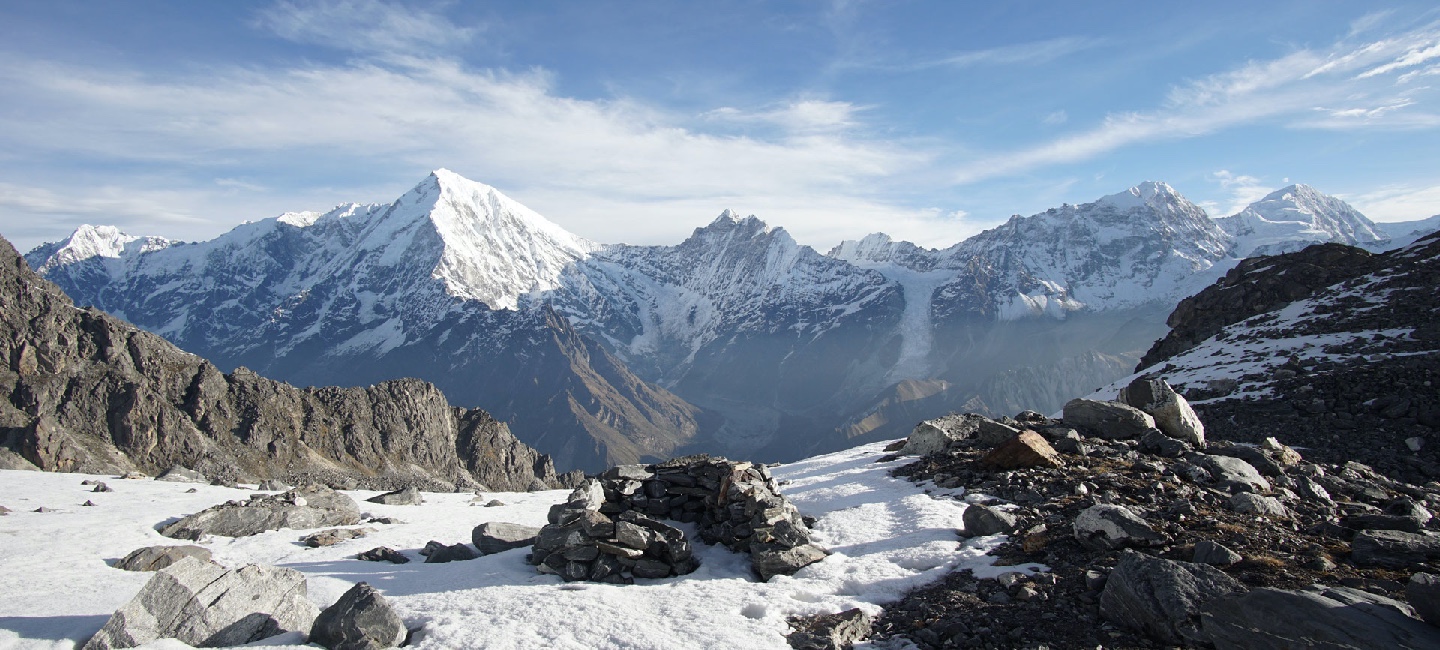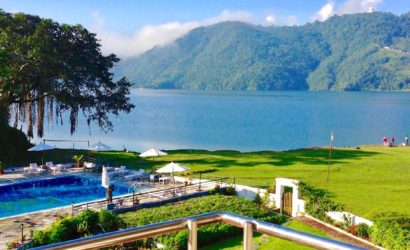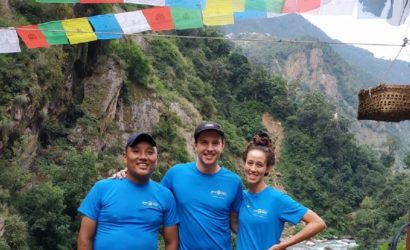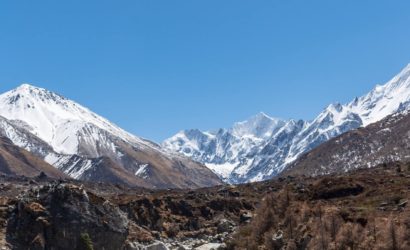Gokyo Lakes, Everest Base Camp and Island Peak Climbing is a wonderful experience in Nepal. This trip of a lifetime is designed for all kinds of trekkers, both serious and amateur. It has a snow-capped and an impressive west face. The beauty and thrill attract many trekkers to the Island Peak.
The journey is following the classic Everest Base Camp trek. You’ll be heading northeast through the Khumbu Valley experiencing the Sherpas culture and hospitality. At Phakding, Namche, Dingboche, Tengboche and Lobuche the tea houses will welcome you for a comfortable stay.
Visiting the Everest base camp, you’ll also be climbing the Kala Patthar, a famous nearby highest point. This summit provides a stunning view of the Everest, Nuptse, and Lhotse. From Dingboche, you will head towards the Island peak.
It’s challenging to climb the Island Peak and you need to be prepared with equipment like crampons and ice axes. This trek is also popular and in high demand due to the challenging journey.
Atop the Island Peak, the mesmerizing breathtaking views of Ama Dablam, Lhotse and more are worth all the hard work. If you are determined to conquer this peak, some stamina training will be a plus point. Well, the descent can be enjoyable. You will descend via Chhukung, Dingboche, Tengboche and Namche Bazaar before you arriving Lukla via Phakding. The descending is quite quick.
The pathway to the Everest Base Camp passes through a number of Sherpa villages that will give you a good glimpse of local Sherpa culture and its hospitality. The guest houses are absolutely comfortable at such altitudes.
It’s not to be missed the flora and fauna. The biodiversity is unique and you can see nature in its true form.
Trip Difficulty Level
Gokyo Lakes, Everest Base Camp and Island Peak Climbing is a challenging, but if you’re in good physical condition we’ll get you to the peak. If you’ve been trekking to altitude before, that’s a great next goal.
The first part of the climb is very physically challenging because you are trekking up rough terrain at more than 5000 m. This part is definitely non-technical though. You’ll have to wear crampons and rope-up when you enter the glacier zone.
During this section there is a risk of falling into snow-capped crevasses These ladders will be strapped to get across. This can be challenging but you will be on safety lines at all times. You finally reach the foot of the headwall.
This is the hard part of the climb as the climb is very steep, and the air is very thin. Fixed lines make the climbing route safe but it will take a great deal of determination to get to the summit ridge. A short, fairly easy ascent from the summit ridge to the top.
How Much Does it Cost to Do This Trip?
An experienced and reliable local tour operator will likely charge from USD 3000 to USD 3500 for an all-inclusive package.
What’s the Best Time of the Year to Do This Trip?
You can go trekking to the Everest region at any time between September and the end of May. Considering the height of Island Peak and the challenging conditions, we work with much smaller windows of opportunity.
Bad weather on base camp walk might be inconvenient, but on Island Peak it might be really dangerous. To safely climb Island Peak, we only go on trips from mid-September through November, and from March through May. The temperatures are good during these times and the most of the days are warm and sunny.
Most interestingly, during these times the strong winds that follow the monsoon die down, and there are long periods of relative calm ideal for climbing.
Island Peak Climbing Gear List
Your personal Gear:
- Ice axe
- Crampons
- Harness
- Tape slings (2)
- Screwgate carabiners
- Descender/Abseil device
- Plastic Mountaineering Boots
- Ascender
- Helmet (optional)
Gears for the Group
- Snow bar
- Rope
- Ice hammer
- Ice screw
Upon your arrival in the Kathmandu airport after completing your custom formalities Visa, etc. pick up your luggage and look for our airport representative from Himalaya Discovery, who will display your name on the board at the arrival gate.
You will be greeted by our representative and transferred to your hotel by private tourist vehicle.
Today is free for sightseeing in Kathmandu. You may wish to visit Durbar Square in the heart of the old town, where the old Royal Palace is located, with its intricate wood-carving.
The entire zone is a maze of temples and images. Narrow alleys, full of the most impressive variety of shops and stalls, lead away from the square in every direction. Some of these landmarks are considered World Heritage Sites including the historic Bhaktapur Durbar Square, the famous Swayambhunath ‘Monkey Temple,’ and Buddhist shrine Buddhanath which is one of the world’s largest Stupas.
There’ll also be a full trip briefing with gear check today. If you need to locally hire or buy equipment there will be time to do this today. Overnight in Kathmandu.
Due to air traffic at Kathmandu Airport. Now, the flight from Ramechhap to Lukla (instead of Kathmandu – Lukla – Kathmandu) which takes about 20 minutes. Lukla is the gateway to Khumbu and to the entire region of Everest.
Our trek begins from Lukla following a gentle climb through the left bank of the Dudh Koshi River. The Dudh Kosi approaches as we pass by mani walls and arrive at a teahouse at Ghat.
Continuing to follow the left bank of Dudh Koshi to Phakding, the route continues along a narrow trail with several climbs and descents. Overnight at guesthouse.
We leave Phakding and follow the trail that crosses a stream before climbing the terraced hill until we get to Bengar. From there our trek continues along the path with lots of ups and downs and we make a stop at the National Park Service where the entrance fee is collected.
As the mountain path zigzags uphill, we emerge at a ridge top resting place that offers great views of Everest and Lhotse. As the path goes along the pine forest to reach Namche Bazaar – the capital of Sherpa, the climb is somewhat eases. Namche Bazaar has lodges, tea shops, cafes and souvenir shops abounding. Overnight at guesthouse.
Acclimatization is very important for preventing high altitude sickness. Today we have an acclimatization rest day at Namche Bazaar. It is a perfect place to spend a rest day for acclimatization at the high altitude before heading off towards Dole.
We can hike up to the Khunde Hospital set up by Sir Edmund Hillary for acclimatization, or a one-hour walk walk up to the Syangboche 3800m for an incredible view of Everest, Nuptse, Lhotse, Ama Dablam, Thamserku and Kusum Kangaru. Overnight at guesthouse.
From Namche Bazaar our route goes all the way up to Khumjung, a picturesque village that also has its own gompa on top of the village. Today, we will have excellent views of Thamserku, Kantega, and Ama Dablam.
Soon after leaving Khumjung, we’ll follow the trail that climbs up a ridge to a large Chorten. We walk along a steep downhill that passes through Phortse Tenga, and from there we climb steeply through rhododendron and birch forest to Dole. Overnight at guesthouse.
We start climbing gradually from Dole along the valley side, where the small, thorny bushes give way to scrub juniper as the altitude increases.
Our trail passes many summer settlements which are used to graze in the summer months when yaks are taken to these pastures.
A splendid view of Cho Oyu lies ahead of us, while the peaks of Kantega and Thamserku are back down the valley. This is a short day, and we arrive in time for lunch at Machhermo. Overnight at Guesthouse.
Today, we’re trek towards the Gokyo Lakes. We must take a very beautiful route to Pangka and then go down slightly before ascending a steep rocky path on the side of the glacier to the valley, passing the first of the holy lakes.
Soon, we will arrive at the second of the lakes, crossing the path leading to Cho La Pass at 5420 meters across the glacier – our route to Lobuche and Everest, later on in the trek. The 3rd Lake is known as Dudh Pokhari and the settlement of Gokyo is located on its eastern shore.
Walking alongside the lake, the scenery is spectacular with the peaks of Cho Oyu and Gyachung Kang reflecting in its green emerald waters. Overnight at guesthouse.
Gokyo Valley offers so many attractions to its visitors. Sherpa people run lodges to provide the trekkers the best facilities. Gokyo is located alongside of Ngozumba Glacier, Nepal ‘s biggest glacier. Today we will do a side trip across Forth Lake to Firth Lake. Overnight at guesthouse.
Gokyo Ri stands above the village on the northern edge of the lake. We will make an early start and follow the trail that is a steep path up the hillside. When at the top of Gokyo Ri, we are rewarded with breathtaking views of the majestic summits of Everest, Lhotse and Makalu.
The viewpoint is considered to be one of the finest in the Everest region – some people say that it is even better than Kala Patthar. After spending quality time at the top, we will descend back to Gokyo and from there we will trek to the Thanknag village on the Ngozumpa Glacier shore. Overnight at guesthouse
From Thanknag, we follow the trail that gradually ascends along the valley to the crossing of the adventurous – Cho La Pass. Most of the time, the Cho La Pass is covered with blue ice which gives a chill feeling to its trekkers.
We will enjoy the panoramic view of several snow-capped mountains along the Gokyo Valley. From here, the trail goes down steeply for about an hour, and then down slightly to Dzongla. Overnight at guesthouse.
From Dzongla, we take the trail that runs through the Khumbu Glacier. On the route we will see the memorials on the glacier of those who died. We follow the trail passing through Lobuche after crossing the glacier and then continue our trek towards Gorakshep. Overnight at Guesthouse.
After breakfast, we will visit Everest Base Camp. We will follow the trail weaving through the ice pinnacles and over the Khumbu Glacier crevasses. We’ll meet some expedition team at Everest Base Camp during the spring season.
We will take a higher route on the return trek back to Gorakshep for stunning views of the Khumbu icefall and surrounding high mountains. Overnight at guesthouse.
We’ll hike to Kala Patthar 5545m early in the morning and enjoy the sunrise view over Mt. Everest 8848m, Mt. Lhotse 8516m, Mt. Makalu 8481 m, Mt. Cho Oyu 8201m and other nearby peaks.
After spending quality time in Kalapatthar, we head back down to Gorakshep and from there follow the route that passes through Lobuche to reach the Dinboche village with a glorious view of Ama Dablam. Overnight at guesthouse.
From Dingboche, we will follow the trail that slowly ascends to the high Imja valley and all the way to the base camp of Island Peak.
We’ll have spectacular and panoramic views of Mt. Ama Dablam 6812 m, Mt. Lhotse 8501 m, Mt. Nuptse 7879 m, Island Peak 6189 m, and other peaks on the way.
We will set up our camp for our overnight stay at the base of the south ridge of Island Peak underneath the giant wall of Nuptse and Lhotse. Overnight at tent camp.
Today, we begin early to achieve the Island Peak Summit. It is best if we reach the summit before midday as the strong winds after midday can create obstacles to the successful summit climb.
We will have to cross many crevasses and overcome difficult parts using ropes, ice axes, harnesses and other equipment for climbing properly. Following the guidance of our climbing experts, we will reach the summit of this physically challenging yet adventurous climb of Island Peak at the same time.
The majestic views of Mt. Lhotse 8501m, Mt. Makalu 8475m, Lhotse Middle Peak 8410m, Lhotse Shar 8383 m, Mt. Nuptse 7879m, Mt. Baruntse 7129m and other high peaks are rewarded from the top of the Island peak. We slowly retrace our steps back toward Island Peak Base Camp after achieving the summit. Overnight at tent camp.
After successfully summit of the Island Peak, our return journey heads back towards Dingboche through the same route from Island Peak Base Camp. Overnight at guesthouse.
We start to descend from Dingboche on a relatively moderate trail which passes through Tengboche. Our journey from there declines further down to the village of Trashinga through forest zones and continues our trekking on the trail that takes us back to Namche Bazaar. Overnight at guesthouse.
The last day of our Gokyo to Everest Base Camp with Island Peak trip will lead from Namche Bazaar to Lukla via Monjo. The trek is a beautiful trek, except a few short uphill climbs and then down to the Bhote- Koshi River crossing it 3 times. The last 45-minute uphill climb will take us back to Lukla. Overnight at guesthouse.
We take a flight from Lukla to Kathmandu early in the morning. Enjoy the amazing mountain flight after the great experience of trekking to Gokyo, Everest Base Camp to Island Peak Climbing along with Himalaya Discovery.
You can spend the rest of your day walking down the Thamel market streets in Kathmandu or simply relax before heading back to home.
As per your flight schedule, our representative will drop you off at the international airport.









